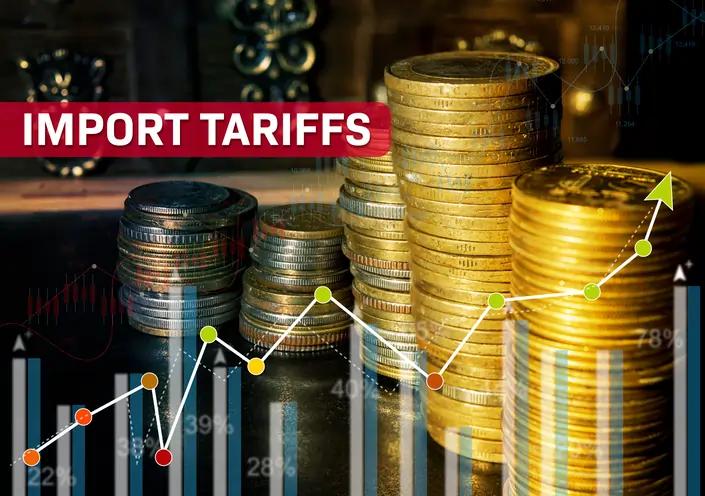Understanding Tariffs: Their Impact on Businesses and Consumers
Understanding Tariffs: Their Impact on Businesses and Consumers
Published by Jessica Weisman-Pitts
Posted on March 10, 2025

Published by Jessica Weisman-Pitts
Posted on March 10, 2025

Tariffs, often a central topic in international trade discussions, are taxes imposed on imported goods and services. While they have long been used as a tool for protecting domestic industries and generating government revenue, their economic implications are far-reaching, influencing everything from global supply chains to consumer prices. In early 2025, the role of tariffs has become more pronounced than ever, as new trade policies reshape the global economic landscape, leading to significant shifts in business strategies, manufacturing costs, and household expenses.
For businesses, tariffs introduce new challenges, forcing them to adapt pricing strategies, reassess supply chain logistics, and navigate increased operational costs. At the same time, consumers bear the burden of these trade policies through higher prices on everyday goods, ranging from automobiles and electronics to groceries and household essentials. The economic consequences of these measures extend beyond simple cost adjustments, affecting job markets, investment flows, and overall economic growth.
With international trade valued at trillions of dollars annually, even minor shifts in tariff structures can have widespread consequences. In 2025, however, these shifts are anything but minor. The latest round of tariffs has sparked intense debate among policymakers, economists, and industry leaders, with some advocating for their necessity to protect domestic industries, while others warn of potential economic downturns and inflationary pressure. Understanding how these tariffs influence businesses and consumers is crucial for grasping the broader implications of trade policy and its evolving role in the global economy.
The Current Tariff Landscape
Trade tensions have escalated in 2025, with tariff policies shifting rapidly and reshaping the global economy. Businesses that rely on international supply chains are navigating new cost pressures, while consumers face rising prices on a broad range of goods. According to Reuters, ongoing tariff measures could disrupt nearly $2.2 trillion in annual trade, underscoring the magnitude of these economic shifts.
What began as targeted trade restrictions on select industries has evolved into a broader pattern of economic protectionism, with major economies implementing countermeasures in response to each other’s policies. These developments are forcing companies to rethink sourcing strategies, adjust pricing models, and, in some cases, relocate manufacturing to mitigate risks. Industries with heavy exposure to international trade—such as agriculture, automotive, technology, and retail—are facing significant operational challenges as they contend with fluctuating costs and supply chain delays.
Beyond corporate concerns, consumers are already feeling the effects of these policies. Higher import costs are driving up prices on everyday goods, from household essentials to electronics and vehicles. While some businesses have absorbed portions of these added costs, many are passing them on to consumers, further contributing to inflationary pressures. The full impact of these trade shifts is still unfolding, and financial analysts warn that prolonged volatility could have broader implications for economic growth and market stability.
Economic Impact in Numbers
The economic consequences of shifting tariff policies are already being felt across industries, financial markets, and households. With global trade valued in the trillions, even moderate disruptions can have ripple effects that extend far beyond the industries directly targeted. However, the current wave of tariff measures is anything but moderate—economists warn that prolonged trade restrictions could have long-term consequences for national and global economic growth.
According to Yale’s Budget Lab, real GDP growth in the United States is projected to decline by 0.6% in 2025, as businesses absorb higher costs and adjust to supply chain disruptions. Over the long run, the U.S. economy is expected to be 0.3% to 0.4% smaller, translating to $80 billion to $110 billion in lost economic output. These figures highlight the broader impact of tariffs beyond immediate price increases, demonstrating how trade policy influences investment decisions, corporate expansion, and employment.
The impact is also being felt in financial markets. Reuters reports that major U.S. stock indexes have suffered steep losses as investor sentiment weakens in response to trade policy uncertainty. The Nasdaq Composite fell more than 4% in a single trading session, while the S&P 500 declined by 2.7%, marking an 8.5% drop from its all-time high just weeks earlier. These declines reflect broader fears that ongoing tariff escalations could push the economy closer to a recession, with businesses delaying investments and consumers tightening spending in response to rising costs.
Tariff-related uncertainty is affecting corporate decision-making, with some businesses reevaluating expansion plans and adjusting operations in response to shifting trade costs. While certain industries may experience temporary advantages due to reduced foreign competition, others face increasing production expenses and supply chain disruptions. These economic pressures, alongside market volatility, remain key concerns for policymakers and business leaders alike.
Impact on Businesses
The effects of recent tariff policies have been immediate and far-reaching, disrupting supply chains, increasing production costs, and altering competitive dynamics for businesses across multiple industries.
Supply Chain Disruption
According to RBC analysis, if tariffs remain in place for three months or longer, the U.S. economy could experience zero growth in 2025. This uncertainty has forced businesses to restructure supply chains, seek alternative suppliers, and reconsider operational strategies. Companies that previously relied on low-cost international sourcing now face higher import duties, prompting some to shift production domestically or relocate operations to tariff-free regions. However, these adjustments come with logistical challenges and added expenses, affecting overall efficiency.
Manufacturing CostsIn response to U.S. tariff policies, China has announced countermeasures targeting 15% of U.S. exports, affecting approximately $21 billion worth of trade. This has created additional challenges for U.S. manufacturers and exporters, particularly those reliant on Chinese markets for sales or materials. Higher costs for raw materials such as steel, aluminum, and electronic components have squeezed profit margins, forcing businesses to either absorb losses or pass increased costs on to consumers.
Market CompetitivenessTariffs have significantly altered the competitive landscape for U.S. businesses. Research from Willamette University indicates that the average tariff rate has risen to 19.3%, more than six times higher than pre-trade war levels. As a result, many companies struggle to maintain price competitiveness in both domestic and international markets. Some firms are exploring ways to reduce dependency on foreign suppliers, while others are reconsidering global expansion plans due to rising trade barriers.
Consumer Impact
While businesses grapple with rising costs and supply chain adjustments, consumers are bearing the financial burden of these tariff policies. From everyday necessities to major purchases, price increases are becoming more apparent across multiple sectors.
Price Increases
Tariff-related cost increases are making their way down to consumers, leading to higher prices on imported goods. According to Nationwide Mutual’s chief economist, these tariffs could result in an annual increase of nearly $1,000 per U.S. household. Similarly, the Peterson Institute for International Economics projects that the typical U.S. household will face costs exceeding $1,200 per year as a result of these trade measures. These added expenses put pressure on household budgets, particularly for middle- and lower-income families who spend a larger share of their income on essential goods.
Automotive Sector Impact
The automotive industry is among the hardest hit by rising import costs. According to the American International Automobile Dealers Association (AIADA), new tariffs could add thousands of dollars to vehicle sticker prices, further compounding affordability challenges for consumers already facing high interest rates and rising production costs. As a result, demand for new cars may decline, leading to a slowdown in auto sales and potential job losses in the sector.
Immediate Market Effects
Although the full impact of these tariffs may take time to materialize, early indicators suggest that price increases are already underway. CNN reports that while consumers may not feel the effects immediately, import taxes are expected to raise prices across virtually all consumer goods categories, from electronics and clothing to home appliances and groceries. Retailers and manufacturers are making adjustments—some absorbing the costs to remain competitive, while others are gradually passing them on to consumers.
Looking Forward
As trade tensions persist, businesses, policymakers, and consumers alike are closely monitoring developments for signs of relief or further escalation. While some temporary exemptions have provided short-term relief, the long-term trajectory of tariff policies remains uncertain.
Temporary Exemptions and Policy Adjustments
According to CNBC, the U.S. has granted temporary tariff exemptions for certain Canadian and Mexican goods under the United States-Mexico-Canada Agreement (USMCA). These exemptions, set to expire in April 2025, provide some breathing room for businesses that rely on cross-border trade. However, unless these measures are extended, companies may need to prepare for a renewed wave of cost increases and supply chain disruptions.
Financial Market Outlook
Investors and analysts continue to assess the broader economic impact of these trade policies. Morgan Stanley estimates that if the current tariff regime remains in place, earnings for S&P 500 companies could decline by 5% to 7% through 2026. This forecast highlights the growing concern that trade barriers may weigh on corporate profitability, investor sentiment, and economic growth over the coming years.
The Challenge Ahead
While certain industries may benefit from protectionist measures, the broader economic risks associated with prolonged trade tensions remain significant. The National Retail Federation warns that without policy adjustments, prices on everyday consumer goods will continue to rise, placing additional strain on households. Businesses, meanwhile, face an increasingly complex trade environment, requiring them to stay agile and innovative to navigate shifting regulations.
As global trade patterns continue to evolve in response to these tariffs, adaptability will be key for businesses seeking to minimize disruption. For policymakers, the challenge lies in balancing domestic economic interests with the need to maintain strong international trade relationships. The coming months will be critical in determining whether these measures lead to long-term economic stability or further uncertainty in the global marketplace.
Explore more articles in the Top Stories category











